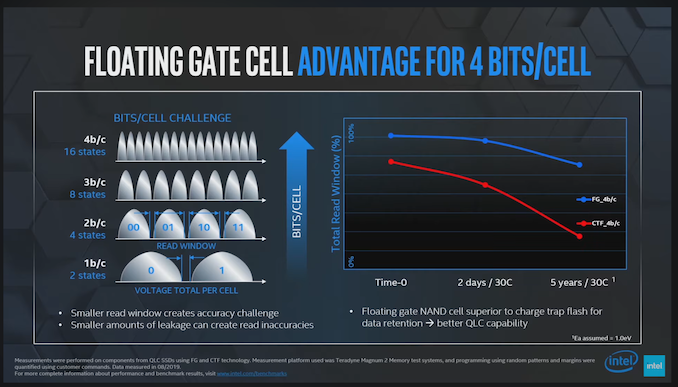Solidigm 122 TB Enterprise QLC SSD Announced for Early 2025 Release
by Ganesh T S on August 7, 2024 3:30 PM EST
Solidigm's D5-P5336 61.44 TB enterprise QLC SSD released in mid-2023 has seen unprecedented demand over the last few quarters, driven by the insatiable demand for high-capacity storage in AI datacenters. Multiple vendors have recognized and started preparing products to service this demand, but Solidigm appears to have taken the lead in actual market availability.
At FMS 2024, Solidigm previewed a U.2 version of their upcoming 122 TB enterprise QLC SSD. The proof-of-concept Gen 4 drives were running live in a 2U server, and Solidigm is preparing them for an early 2025 release.
Given the capacity play, Solidigm will be relying on QLC technology. However, the company was coy about confirming the NAND generation used in the product.

Source: The Advantages of Floating Gate Technology (YouTube)
The 61.44 TB D5-P5336 currently utilizes Solidigm's 192L 3D QLC based on the floating gate architecture. This has a distinct advantage for QLC endurance compared to the charge trap architecture also available to Solidigm from SK hynix. That said, SK hynix's 238L NAND also has a QLC avatar, which gives Solidigm the flexibility to use either NAND for the production version of the 122 TB drive. Solidigm expects to confirm this by the end of year in preparation for volume shipment in the first half of 2025.











4 Comments
View All Comments
SanX - Thursday, August 8, 2024 - link
What is the most reliable part of PC? RAM memory. Works for decades.What is the less reliable part of PC? Flash memory.
Return to MLC not to QLC
shabby - Thursday, August 8, 2024 - link
I've had two sets of corsair ddr4 fail, so I wouldn't say memory.PeachNCream - Thursday, August 8, 2024 - link
Assuming it's used for non-write intensive workloads and doesn't need to store data that is unused for long periods and there is lots of redundancy plus backups (redundancy and backups are normal in any reasonable data storage setting anyhow) then I don't see a problem with hyper-frail QLC that can tolerate like 300 p/e cycles per cell in a mission-critical enterprise setting. Sure its trash-tier NAND that should never, ever have been created, but high data density at low cost is sometimes more important than anything else and I'd MUCH rather see QLC foisted off on enterprises than sitting in a personal compute device I depend on that doesn't have the same level of redundancy and backup.ZeDestructor - Friday, August 9, 2024 - link
I've seen every form of data storage lose data over the years, including pressed optical media. The only real way of doing data storage long-term if you actually care about the data is to regularly check the stored data's integrity (and the integrity of your backups!) and repair any loss that may have happened while you weren't paying attention.